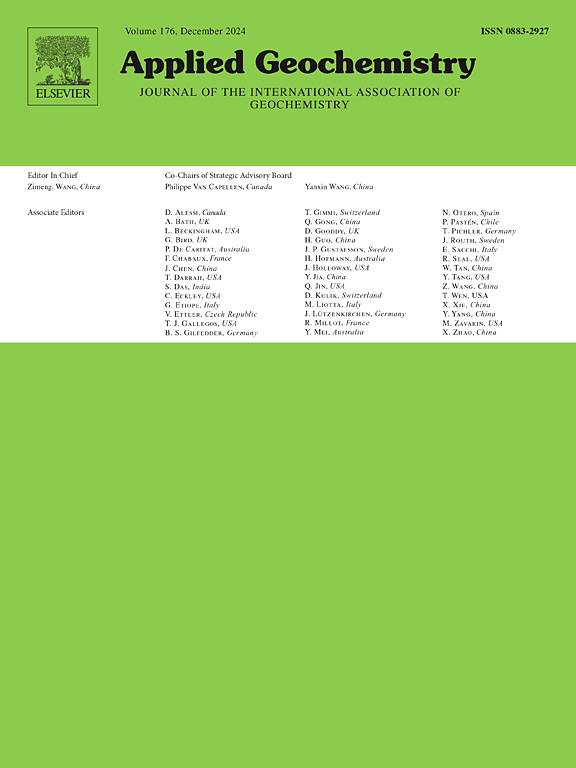Selective recovery of native copper from basalt tailings using alkaline glycinate solution
IF 3.4
3区 地球科学
Q1 GEOCHEMISTRY & GEOPHYSICS
引用次数: 0
Abstract
Mafic and ultramafic rocks present an intriguing pathway for CO2 capture through strategic enhancements to the natural silicate weathering cycle. Simultaneously, these rock types are often hosts to appreciable amounts of metals critical to U.S. energy independence, particularly in the context of alkaline mine tailings from historical metal mining. The research and scientific prerogative, then, is to identify promising mafic and ultramafic feedstocks and conduct exploratory studies to effectively recover these critical minerals while preserving the potential for mineral carbonation. The Keweenaw Peninsula of Michigan hosts the largest native Cu reservoir within basalt in the world and experienced a rich history of Cu production spanning from pre-historic times to the mid-1900s. Today, much of the Cu mining legacy remains as mine waste tailings. In this study, we examined the Cu extractability from Keweenaw Basalt tailings using a sodium glycinate solution, in comparison with acid and sodium hydroxide leaching. Experimental results showed an 85 % Cu extraction rate using sodium glycinate as the extraction solution with negligible release of other cations from the basalt. The kinetic and extraction mechanisms of Cu selective recovery using glycinate solution were discussed using time-resolved experimental data and kinetic geochemical modeling. Theoretical estimation of carbon mineralization potential of all the existing basalt waste tailings (∼500 million tons) can reach 85.5 MMT CO2. A total of 0.786 MMT Cu can be recovered with sodium glycinate, with a value of 7.7 billion USD. This novel application of alkaline glycinate for selective Cu recovery from basalt mine tailings demonstrates the viability of selective metal recovery using a non-hazardous chemical while preserving CO2 capture potential and presents a potential pathway toward reducing energy-related emissions and providing an unconventional domestic source of critical minerals.

碱性甘氨酸盐溶液选择性回收玄武岩尾矿中的天然铜
镁铁质和超镁铁质岩石通过战略性地增强天然硅酸盐风化循环,为二氧化碳捕获提供了一条有趣的途径。与此同时,这些岩石类型通常是大量金属的主人,对美国的能源独立至关重要,特别是在历史上金属开采的碱性矿山尾矿的背景下。因此,研究和科学特权是确定有前途的基性和超基性原料,并进行探索性研究,以有效地回收这些关键矿物,同时保留矿物碳酸化的潜力。密歇根州的Keweenaw半岛拥有世界上最大的玄武岩原生铜储层,从史前时代到20世纪中期,这里经历了丰富的铜生产历史。今天,许多铜矿的遗产仍然是矿山的废尾矿。在这项研究中,我们研究了使用甘氨酸钠溶液从Keweenaw玄武岩尾矿中提取铜的可提取性,并与酸浸和氢氧化钠浸出进行了比较。实验结果表明,以甘氨酸钠为萃取液,铜的提取率为85%,而其他阳离子的释放可以忽略不计。利用时间分辨实验数据和动力学地球化学模型,讨论了甘氨酸盐溶液选择性回收铜的动力学和萃取机理。理论估算现有全部玄武岩废尾矿(~ 5亿吨)的碳矿化潜力可达85.5 MMT CO2。甘氨酸钠共可回收铜0.786 MMT,价值77亿美元。碱性甘氨酸盐在玄武岩尾矿中选择性回收铜的新应用表明,在保留二氧化碳捕获潜力的同时,使用非危险化学品进行选择性金属回收的可行性,并为减少能源相关排放和提供非常规的国内关键矿物来源提供了潜在途径。
本文章由计算机程序翻译,如有差异,请以英文原文为准。
求助全文
约1分钟内获得全文
求助全文
来源期刊

Applied Geochemistry
地学-地球化学与地球物理
CiteScore
6.10
自引率
8.80%
发文量
272
审稿时长
65 days
期刊介绍:
Applied Geochemistry is an international journal devoted to publication of original research papers, rapid research communications and selected review papers in geochemistry and urban geochemistry which have some practical application to an aspect of human endeavour, such as the preservation of the environment, health, waste disposal and the search for resources. Papers on applications of inorganic, organic and isotope geochemistry and geochemical processes are therefore welcome provided they meet the main criterion. Spatial and temporal monitoring case studies are only of interest to our international readership if they present new ideas of broad application.
Topics covered include: (1) Environmental geochemistry (including natural and anthropogenic aspects, and protection and remediation strategies); (2) Hydrogeochemistry (surface and groundwater); (3) Medical (urban) geochemistry; (4) The search for energy resources (in particular unconventional oil and gas or emerging metal resources); (5) Energy exploitation (in particular geothermal energy and CCS); (6) Upgrading of energy and mineral resources where there is a direct geochemical application; and (7) Waste disposal, including nuclear waste disposal.
 求助内容:
求助内容: 应助结果提醒方式:
应助结果提醒方式:


